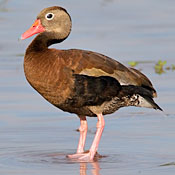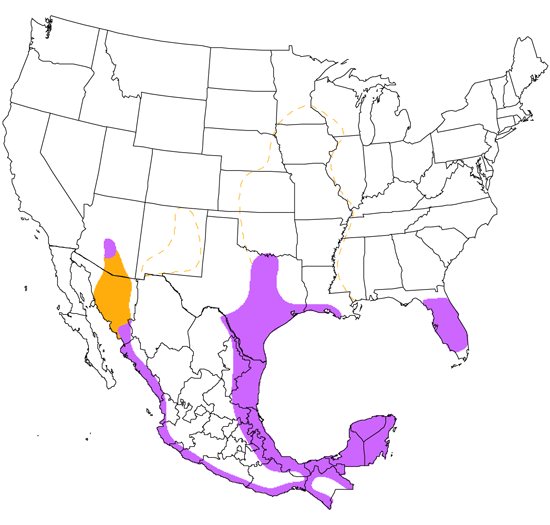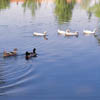Black-bellied Whistling-Duck
Dendrocygna autumnalis

Duck Like

Length: 21 in. (53 cm )
Usually seen in marshy areas with trees, along forested streams, and on muddy beaches, this large duck also grazes in flooded rice fields, pastures and grassy golf courses. The nest is in a tree cavity high above the ground, but occasionally they nest on the ground among dense grasses in a marshy area. Several females will sometimes dump their eggs into a common nest, and up to 100 eggs have been found in a single nest. The most common foods are seeds, grain and some snails and insects.
The four-digit banding code is BBWD.
Bibliographic details:
- Article: Black-bellied Whistling-Duck
- Author(s): Dr. Biology
- Publisher: Arizona State University School of Life Sciences Ask A Biologist
- Site name: ASU - Ask A Biologist
- Date published:
- Date accessed:
- Link: https://askabiologist.asu.edu/activities/bird/black-bellied-whistling-duck
APA Style
Dr. Biology. (). Black-bellied Whistling-Duck. ASU - Ask A Biologist. Retrieved from https://askabiologist.asu.edu/activities/bird/black-bellied-whistling-duck
Chicago Manual of Style
Dr. Biology. "Black-bellied Whistling-Duck". ASU - Ask A Biologist. . https://askabiologist.asu.edu/activities/bird/black-bellied-whistling-duck
Dr. Biology. "Black-bellied Whistling-Duck". ASU - Ask A Biologist. . ASU - Ask A Biologist, Web. https://askabiologist.asu.edu/activities/bird/black-bellied-whistling-duck
MLA 2017 Style
Be Part of
Ask A Biologist
By volunteering, or simply sending us feedback on the site. Scientists, teachers, writers, illustrators, and translators are all important to the program. If you are interested in helping with the website we have a Volunteers page to get the process started.




